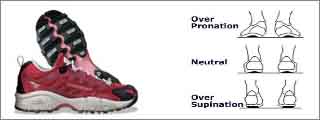Running Shoes
are wearing your attitude, most of it has then got to do with understanding your running style and your feet better and getting some basics on the simplest of running gear - good socks and appropriate running shoes and focusing on your running form.
Know your feet
rep which one I preferred - they were all white, all much more expensive than anything I had bought so far and I had no clue!! I had chosen running shoes so far based on the colour and low price!!

dynamic view of your gait and is the clincher for deciding what type of shoes suit you best.
your feet need. If you see a pretty complete imprint of your feet, then you are flat footed and your feet probably need a 'motion control running shoe' with a hard arch in the midsole - normally a very stiff mid part of the shoe. If you are normal arched
then you probably need a neutral running shoe.
with the ground, just before lift off. A simple way to educate yourself is, next time you are walking or running in a park – just focus on the people in front of you and see how their feet at rolling inwards. You will also start noticing some really
worn out shoes. The next step is to either run and view yourself in front of a mirror, or get someone to take a video of your foot contact on the floor – from the rear, or get someone to run behind you and talk to you about your pronation. The other
is to flip your 3-6 month old running shoes over and see where they are worn out. If it is more worn out in the inner sides, you are overpronating, and if it is worn out on the outer sides, you are more of an overpronator and need appropriate shoes
to balance out the same.

That will really get you to enjoy your runs. Educate strangers in the park too about what they need to do about their shoes. Most will appreciate you for it.
your running shoes, and experience the difference.
only one pair of feet - look after them.
many of the reps in shoe stores are not very knowledgeable about running shoes for the different feet types, so it's best you do a quick check on the runnersworld link,
and then check out the shoe models for your foot type in the US sites of Nike, Adidas, Reebok, New Balance, Brooks, Asics, Mizuno - or whatever other brand you may be considering, (or just look at the table and shoe finder below) and then go to a multibrand
outlet and try on the shoes.
Long distance and regular runners need to focus on running form
This is perhaps even more important than your foot arch and the amount you pronate. If you are a heel striker - see how you can review landing on your mid foot and the lean forward from the ankle (not waist) while running. Wearing a thin sole shoe may
work towards getting you to land more on the mid foot as landing on your heel will be painful.Keep experimenting on improving your running form in your shorter runs and get your mates to comment on your foot landing. This will get to understand what type
of shoe better suits you in the long run. If you land on your mid foot then buying a neutral shoe may be worth trying out even if you over pronate.
Tips to buy your running shoe
Feet swell over the course of the day or while running for a while, so it’s better to shop in the evenings, wearing the socks in which you would run. Shoe sizes and widths vary by brands, so definitely check out a few, more by fit than by size number
alone. In the stores, try on, and walk in, several pairs. Insert your thumb between your heel and the shoe—there should be wiggle space. The fit of the running shoe should not be snug. Do not listen to sales talk that the shoe will loosen up with wear.
Learn from the first store and then check out the next. Do not assume that the most expensive running shoe is the best for you. You have only one pair of feet which is taxed every single day of your life. Buy shoes that are designed for YOUR feet and
will protect them, keeping you comfortable. You will be amazed at how many pains and aches suddenly disappear, your feet no longer ache in the evening, or you no longer have aching shins during light exercise.
Try some barefoot running or minimalist shoes for your running too - it definitely helps to mix and match your running surfaces and shoes and focus on form and get more aware of how you run and what works best for you. Now that you have your shoes which
are best suited for your feet you may still find you have an issue as you may have wide toes, or the shoe heel is a bit loose, or you are high arched and the top of your foot rubs against the tongue of the shoe. See how a simple variation in lacing can
go a long way in helping you. Click here. And then as you start running on different surfaces, buy a separate shoe for trail running, and a separate one for road racing which will
be lighter than your regular everyday road running shoe. Enjoy the run. If you would like to receive an e-mailer on information on runs and running events - drop us a mail at contactus@runningandliving.com and
send us your name and city of residence

 contactus@runningandliving.com
contactus@runningandliving.com click here
click here click here
click here